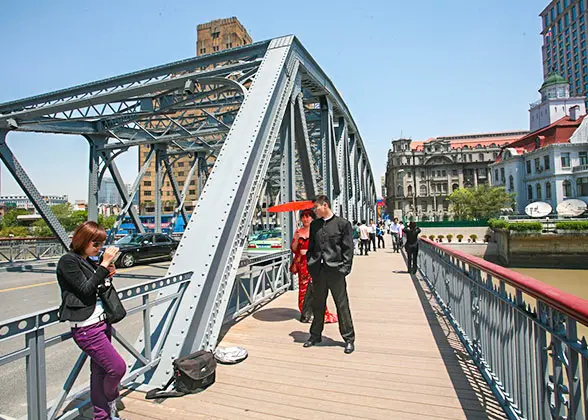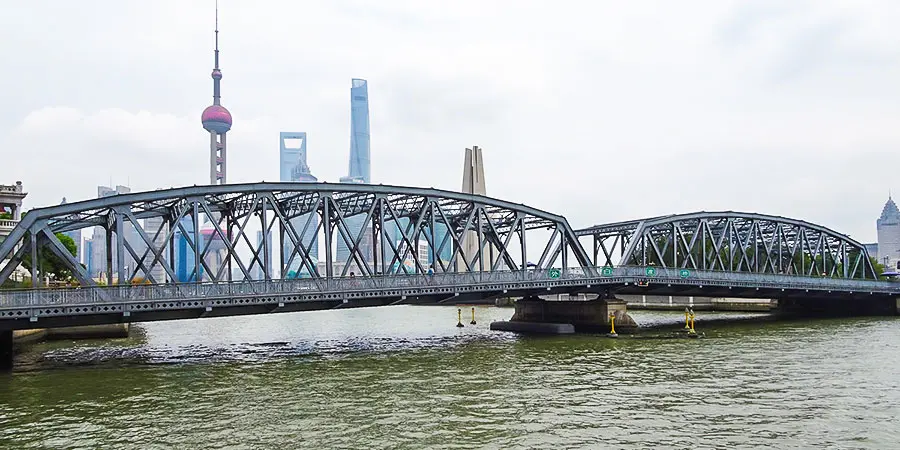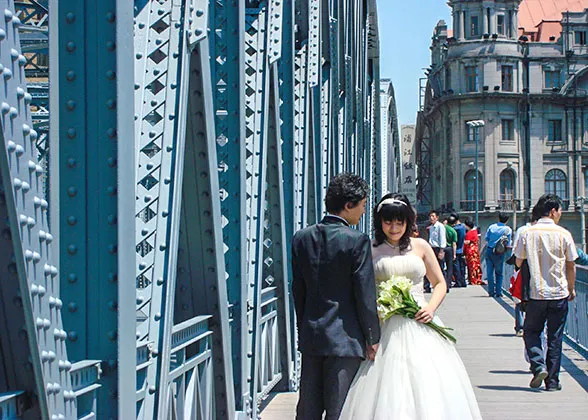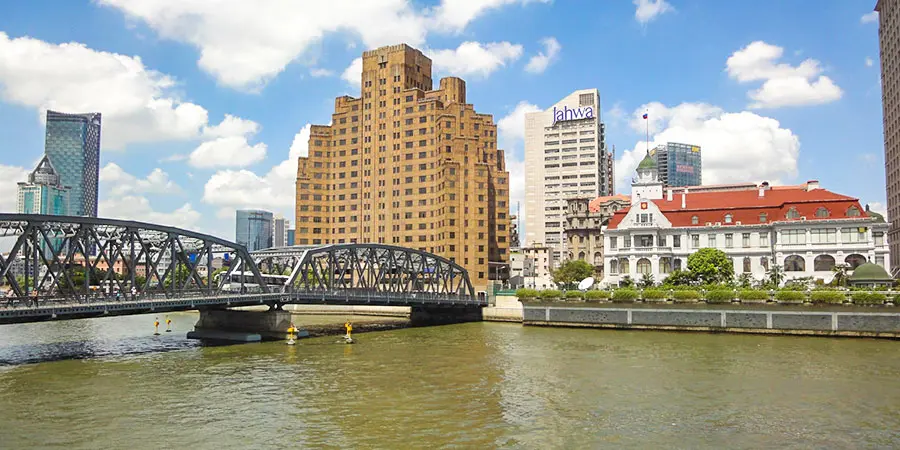Waibaidu Bridge
Waibaidu Bridge Facts
 |
Name: Waibaidu Bridge, Garden Bridge
Chinese Name: 外白渡桥
Length: 106.7 meters (350 feet)
Initial Construction: 1856
Location: At the north end of the Bund over the Suzhou Creek
Waibaidu Bridge is one of the landmarks of the old city of Shanghai, spanning the Suzhou Creek, and at the confluence of this creek with the Huangpu River. It is the earliest and largest steel bridge in the city, stretching from north to south. In addition of its traffic function, the bridge, joining the north end of the Bund and facing the rippling Huangpu River, serves as a view point for visitors to enjoy the splendid skyline of Pudong. Going through over 100 years, Waibaidu Bridge has witnessed the vicissitudes of Shanghai.
Over 150 Year's History
About 150 years ago, with no bridge over Suzhou Creek, the only way to get across was by ferry. Because of the settlement of foreign concessions on two sides, the ferry couldn't cope with the increasing passenger volume. So, a British businessman named Wills directed the building of a large wooden bridge, Wills Bridge, beyond the river in 1856. Folks called it Waibaidu because it was located at the Outside Ferry (Waibaidu). Chinese had to pay to cross the bridge, and this triggered off a storm of protest. In order to calm the masses, a wooden bridge, named Garden Bridge, was built to the west of it, free to the public. Later, the old bridge was demolished. In 1908, a steel bridge was constructed to replace the wooden bridge so as to allow streetcars over the river.
 |
Scenery Seen from Waibaidu Bridge
 |
Walking on the bridge, visitors can enjoy the distinctive scenery on both banks of Suzhou Creek, with old-fashioned alleys at the north end and western buildings on the south. During the night, the landscape lighting renders the bridge even more gorgeous and lively. From here the Bund, the Cenotaph to the People's Hero and the Bank of China Building are clearly visible. Looking east to the opposite bank of Huangpu River, the Oriental Pearl Tower, Riverside Avenue, Jin Mao Tower and the World Financial Center are all brightly lit. In summer, it's a very pleasant experience to enjoy the breeze along the Huangpu River and listen to the ship whistling, while wandering on the bridge.
Constructions at Two Ends
The most attractive places at the south end of the bridge are Huangpu Park and Rockbund. Huangpu Park is one of the most beautiful spots on the Bund, completed in 1868. The Cenotaph to the People's Hero, History Museum of the Bund and the large-scale relief all can be seen in the park. The wide trees and flowers in the park immerse you in the cozy garden landscapes. To the west of the park, groups of old western buildings, which were built at the beginning of the 20th century, are gathered in a region called Rockbund, which is the origin of the Bund, containing the earliest western buildings.
Shanghai Mansion, also named Broadway Mansion, is a five-star foreign hotel, standing straight at the north end of the bridge. It was built in 1930 and took four years to complete. Walking to the east, you will see the elegant Consulate of Russian Federation, which started construction in 1914 and finished in 1916. During that time, the relation between the two countries was changing constantly, so the consulate had been closed and reopened for six times, which was regarded as one of the strangest events in the world's history.
 |
How to get to Waibaidu Bridge
To the south end:
The bridge is at the north end of the Bund. Visitors can take buses 33, 37, 55, 65, 305, 307, 317, 330, or 868, to Zhongshan Dongyilu (Beijing Donglu/Nanjing Donglu) Station. Then walk north to the bridge. Or take City Sightseeing Bus Line 1, Line 3, or Line 5 to get there.
To the north end:
Take bus 19, 61, 100, or 317 and get off at Wusonglu Tiantonglu Station. Then walk south to the bridge.
Take bus 868 or 934. Get off at Changzhilu Minhanglu Station and walk south.
Take bus 22 to Minhanglu Changzhilu Station, and then walk south.
Shanghai Bus / Metro Search
| Admission Fee | Free |
| Opening Hours | All Day |
15 Free Things to Do in Shanghai
11 Most Romantic Places for a Honeymoon in Shanghai